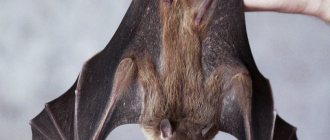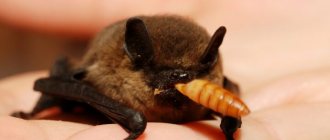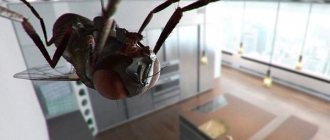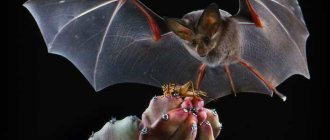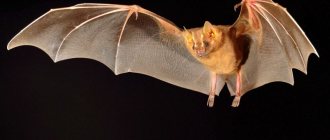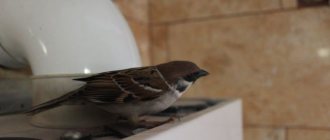There are many different beliefs associated with bats, according to which these small animals are representatives of evil spirits, vampires, and the well-known Dracula. And if we add to this the unpleasant appearance of bats, it becomes clear why many are confused and even scared when at least one representative of this tribe flies into their house.
What to do
According to local folk beliefs, the arrival of a night visitor is associated with a warning of misfortune. In China, the appearance of an animal is welcomed - it is believed that it signals good luck in business and an imminent improvement in the family’s financial situation. What does the visit of a winged guest mean from a biological point of view:
- young age - inexperienced mice, in the heat of excitement, miss and fly into open windows;
- migration time - the search for new secluded places brings them into houses and balconies.
Important! Bats fly into apartments by mistake, and not for bloodthirsty purposes. The lost guest needs help.
How to catch without a mousetrap
Compliance with safety measures
If a bat flies through the ventilation into the house, then catching it will not be difficult. A person should protect themselves as much as possible from accidental bites: wear thick gloves, a tracksuit or sweater to protect the skin.
Once in an unfamiliar room, the mouse begins to fly hysterically, trying to find a way out. She needs time to calm down and sit on some surface (including walls). Experts advise adhering to the following algorithm for driving away uninvited visitors:
- take an empty medium-sized box so that it covers the mouse along with its wings;
- cover a sitting animal with it;
- carefully insert the cardboard between the wall and the box;
- go out into the street or loggia and free the animal.
All actions are carried out as carefully as possible - so as not to damage the thin wings.
Important! In most countries, the destruction of bats is prohibited - they are listed in the Red Book and are protected by law.
How to drive a bat out of an apartment at night
When unexpected guests appear, there is no need to make noise trying to catch them. Zoologists recommend the following scheme:
- ask all household members to leave the room;
- open the window;
- turn off all lighting sources - chandeliers, night lights;
- go out and close the doors tightly behind you.
After half an hour, look into the room - in 99% of cases, the bat will leave its confines on its own. Otherwise, you can catch a thrashing animal with a thick towel or a net. The main thing when fishing is not to let yourself be bitten or scratched.
Folk remedies
Bat in a trap
Homemade recipes are suitable for those who have encountered a whole colony of animals that have chosen an attic or technical floor in a multi-story building for permanent residence. Permanent residence creates a number of inconveniences: the animals rustle loudly, squeak and squeak their claws on wooden and metal surfaces.
To get rid of constant fuss, you can try several means of expulsion:
- Mothballs - rodents and bats cannot tolerate the aroma emanating from it. Tablets or bags of powder are placed in habitats - near nests or large amounts of droppings. An unpleasant smell will prevent old and new colonies from flying into the attic and establishing a nesting place in it.
- Aromatherapy - special incense sticks or essential oils work no worse than naphthalene. The animals have a negative attitude towards the smell of chamomile, peppermint, and common tansy. Wormwood, dog's tongue, wild rosemary and elderberry roots also repel uninvited guests.
- Loud sounds - heavy rock, turned on for several hours, will give the winged creatures a good shake-up and force them to look for another place to live.
- The sources of noise (you can buy ready-made ones or make them yourself) are a weather vane, Chinese “wind music” or the thinnest metal plates hung close to each other creating a cacophony that is unpleasant for their sensitive hearing.
- Light - bright lighting fixtures simulating daylight and placed around the perimeter of the attic will cause panic among bats. Using lanterns for several nights in a row will drive impostors out of your home.
- Closing the entrances - you need to find all the cracks through which mice enter the home and cover them with polyurethane foam. The procedure is carried out at the moment when the inhabitants have flown away to hunt or have been frightened away from their nests by loud sounds and light.
- Fear - in the daytime, one animal is carefully caught and placed in a box with drilled holes. With the onset of darkness, it will begin to scream, trying to get out and warning its relatives of the danger. The flock will react to its fellow tribesman and leave the den in full force. After they leave, the prisoner is taken outside and released.
Important! Experts recommend using a smoker - bats cannot stand its smell. Before carrying out an action to evacuate uninvited guests, you need to warn your neighbors: vigilant citizens, seeing a smoke screen, can call the Ministry of Emergency Situations.
What should you not do if a bat flies into your house?
If a bat flies into a house or onto a balcony, it is unacceptable to catch it with your bare hands: the bite of the animal can lead to serious, including incurable, diseases.
Chasing a chiroptera in a room, knocking it down with a mop or a broom is unacceptable - you can cripple the animal or collide with it yourself and get bitten.
If a bat is caught, it does not need to be thrown out a window or over a balcony - it must fly away on its own.
On the loose
Important ! It is unacceptable to use bait or aerosols with chemicals - many species of bats are protected by law, so you can receive a large fine for your actions.
How dangerous are pests and diseases?
Contact with bats can lead to serious viral and fungal diseases. A frightened animal, when picked up, bites, along with saliva, transmitting bacteria and viruses directly into the blood of the offender.
The most dangerous pathologies that can be transmitted to humans include:
- Rabies is an incurable disease that requires an immediate visit to the hospital for vaccination. It begins with changes in behavior, unreasonable aggressiveness, anxiety, and headache attacks. As it progresses, the person develops dehydration, paralysis, and death.
- Darling's disease is transmitted by inhalation of spores that rise into the air when moving through the feces of animals. The symptoms of the disease can easily be confused with the flu; the only difference is the absence of fever.
Bats carry many diseases that are fatal to humans. Depending on the area of residence, they are capable of transmitting Ebola, Marburg, Hendra fever, and SARS.
Important! A bite from an animal that collides with a person requires immediate medical attention. The victim will have to undergo a course of rabies vaccinations to prevent rabies infection.
Night guest
A dark, spacious apartment in a high-rise building in the north of Moscow. Nearby are the Northern River Station and the black expanse of the Khimki Reservoir. It's only nine in the evening, but for October it's already night. There are two of us at home - me and my cat Girard.
- Bzhzhzh, boom. Bzhzhzh, boom. Buzzing and the sound of hitting the wall in the kitchen. Apparently a bumblebee flew in, strange. The cat is right there, hunting. I quickly go to my room, where the light is on. The buzzing turned into flapping wings - phhh, phhhh, phhhh. Butterfly? In October?!
The butterfly is no longer there. A bird is flying around the room. From the light of the chandelier, winged shadows stretched half a meter across the ceiling. No, it's not a bird. The creature is larger than a sparrow, but smaller than a dove. Girard bares his fangs and meows. It taps its tail on the floor so hard that blows can be heard. Starts jumping after this creature. This is a bat...
Once - and she stuck to the door, wrapping her wings around it from above. Silence.
After the hunt. Girard studies fishing gear. Photo: portal Moscow 24/Ivan Nosatov
I find myself on the balcony with a notebook in my hand, the door is closed. Breathing is rapid. From afar, I took a video of the night visitor on my phone. “Batman flew into my house!” – emotions were overwhelming, and I was talking complete nonsense. Having calmed down a little, I threw a blanket over the mouse and released it into the Moscow night. She squealed loudly on her way to the balcony. She was scared...
Moscow courtyard in the Levoberezhny district, where the bat was released. Photo: portal Moscow 24/Ivan Nosatov
Neighborhood dangers
Aggressive bat
Unpleasant coexistence with a colony of bats is associated with the interference it creates. People who are faced with the unauthorized colonization of bats make complaints:
- to constant noise - night activity and fussing interferes with sleep, scares children;
- unpleasant odors and dirt - waste products are scattered under permanent habitats, emitting a disgusting aroma;
- unsanitary conditions - animals are carriers of infections and viruses, including those dangerous to humans; their droppings contain many pathogens and parasites;
- roof damage - animals gnaw holes in the insulation and waterproofing of the insulation; their activity requires constant repair of the roof.
The main danger when encountering blood-sucking bats is bites. Automatic protective reflexes of animals lead to infection of people; in Russia, between May and September, they spread rabies. In other species of animals, problems are caused by droppings, as the main transmitter of fungal infections.
Important! Epidemiologists advise cleaning rooms from traces of bats' activity using gloves and a respirator. After treatment, all clothing is disinfected and thoroughly ironed.
Favorite places to live
Unpleasant neighborhood
Before getting rid of bats, it is necessary to locate all their places of residence. Chiropterans prefer to settle in dry rooms, with a large number of protrusions to which they cling and hang upside down:
- in multi-storey buildings they prefer attics and technical floors;
- in apartments, animals nest in the ventilation system or on the loggia;
- in rural areas, encounters with unwanted guests occur more often: wooden structures and poor insulation allow them to be located in chicken coops, cowsheds, outbuildings, and under the roof of residential buildings.
Important! The exact location of the nests is determined by piles of droppings: dark brown interspersed with shiny dots (insect shells). It is impossible to confuse it with the excrement of other animals, including rats and field mice.
Useful facts
There are many myths and stories about chiropteran mammals. But there are real facts you need to know before getting rid of these animals.
They don't build nests
The main reason that flying individuals settle in residential buildings is that they do not nest. They just hang from the ceiling, clinging with their claws.
The appearance of offspring
In mid-latitudes, bats reproduce once a year - towards the end of spring, beginning of summer. The number of offspring in a litter is one or two; triplets are rarely born.
Colonies of females
In summer, females form extensive maternal colonies. Males and barren females always settle separately.
Mating begins in the month of August and continues throughout the fall and winter. Colonies include from 10 to 1 or one and a half thousand individuals.
Night mode
Chiropterans are nocturnal. At night, they hunt insects, as they have an important advantage over other nocturnal animals - echolocation. During the day, mice sleep upside down, falling into torpor.
Disease carriers
Scientists have found that individuals carry more diseases dangerous to humans than other mammals.
Rabies
Chiropterans are long-term hosts and carriers of the rabies virus. But not all species of individuals carry the disease. A person can become infected only through a bite.
See also
For what reasons do plastic windows fog up and what to do about it?
Marburg virus
Marburg virus is spread by mice. The disease causes severe hemorrhagic fever in humans; At the same time, the fatality rate is high.
Ebola virus
Flying individuals can infect people with an acute viral infection without becoming victims of the disease themselves. The virus can then spread through close person-to-person contact.
Histoplasmosis
Chiropterans are carriers of the fungus Histoplasma capsulatum. The infection is found in animal excrement. Therefore, to become infected, it is enough to be nearby and inhale dangerous fumes.
Parasites
Harmful insects settle on flying animals. But they do not threaten people in any way, as they are attached to their owners.
Prevention
To prevent the infestation of bats, simple rules must be followed. Experts focus on the following points:
- space under the roof - even small cracks can serve as an entrance for the compact bodies of animals;
- air ducts and ventilation systems are covered with thin meshes or grilles blocking the passage;
- in areas of possible settlement, hang foil, tins - anything that creates noise during air circulation;
- lighting - animals do not like places where sunlight freely penetrates.
It is better not to use chemicals in aerosols or baits - most bats are protected by law, and their destruction will lead to large fines. You can find out about permitted methods at your local sanitary and epidemiological station. If there are no results in expelling a flock of bats on your own, you can apply for a team specializing in this issue.
The best season for clearing your home of animals is autumn. In winter they hibernate, and in spring and summer they reproduce. Colonies consist of females raising their young. Attempts to breed mice at this time will lead to the death of the young.
Get rid of traces of crime
After a successful hunt, the blanket or towel should be washed with regular detergent. As a rule, most washing powders have an antiseptic effect.
Lyudmila Korobkova dispelled fears that the bat could return, and with friends at that. "Excluded. It was you who had to raise her from the point of view of a mouse, nurse her, and feed her. Accustom her to yourself. Then release. She would return to you, fly in, fly away. She flew away, walked around, ate insects, and returned to the window. And then there is a chance that she would have found a mate and, of course, brought her to you for free feeding,” says the ornithologist.
Photo: TASS/Zuma/Jaroslav Ozana
Bats are not birds and do not lay eggs. They give birth to babies. Moreover, in our strip it is mainly in the spring. Meeting a pregnant female in October is unlikely. They usually bring 1-2 naked, blind cubs, which within 20-40 days begin to hunt on their own.
“Even if she gave birth to someone, they would have already died,” the ornithologist concluded. We talked with Lyudmila Korobkova two weeks after the incident.
